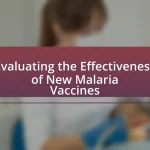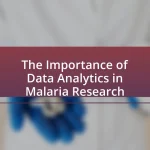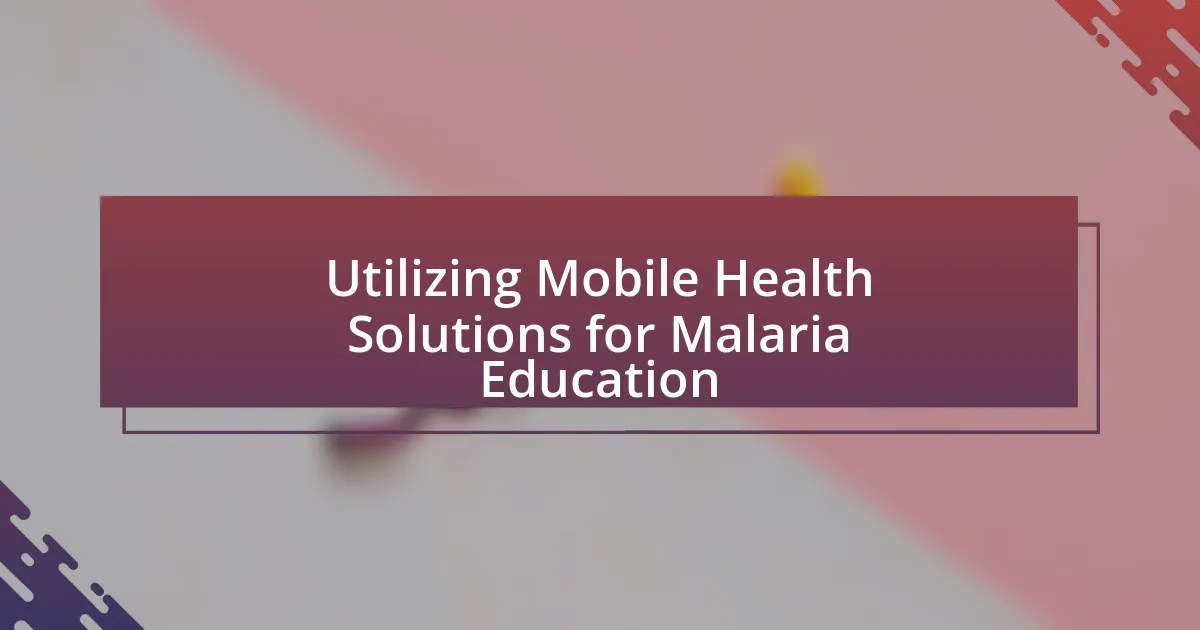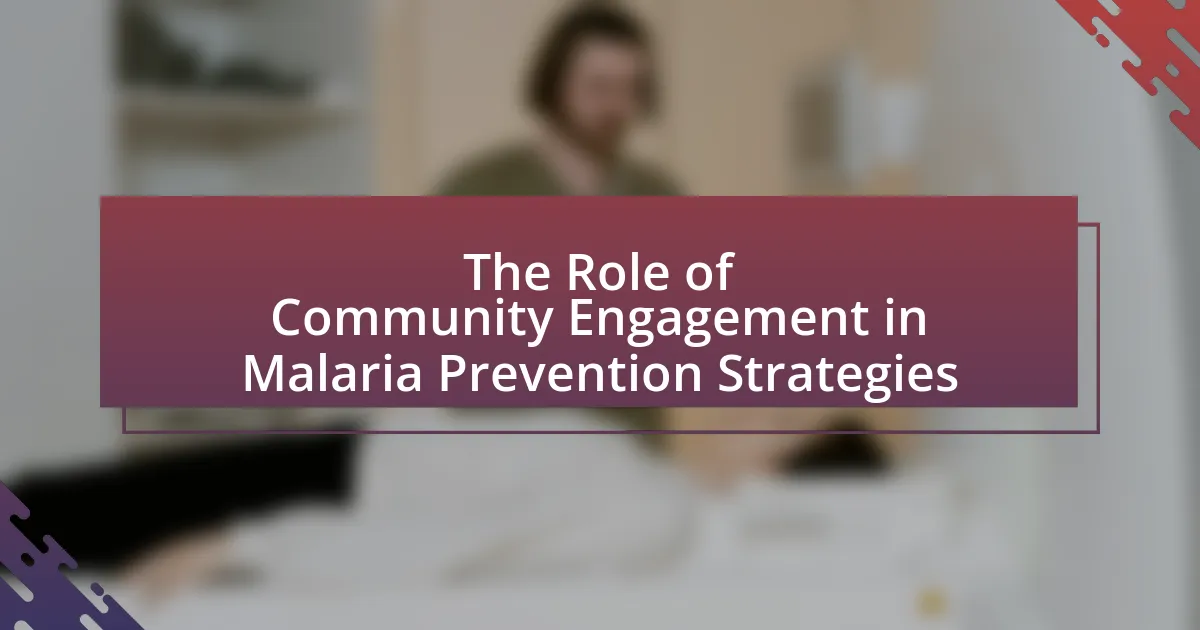The article focuses on the funding challenges faced by malaria prevention innovations, highlighting issues such as limited financial resources, inconsistent donor support, and competing health priorities. It emphasizes the crucial role of funding in developing and implementing effective malaria prevention technologies, detailing the impact of inadequate funding on research, clinical trials, and public health campaigns. The article also explores common funding sources, the barriers innovators encounter in securing grants, and strategies to overcome these challenges, including the importance of advocacy and public-private partnerships. Overall, it underscores the urgent need for increased investment to enhance malaria prevention efforts and reduce the disease’s burden globally.

What are the Funding Challenges for Malaria Prevention Innovations?
Funding challenges for malaria prevention innovations primarily stem from limited financial resources, inconsistent donor support, and competing health priorities. The Global Fund to Fight AIDS, Tuberculosis and Malaria reported that funding for malaria programs has fluctuated, with a significant drop in contributions from some donor countries, impacting the sustainability of innovative prevention strategies. Additionally, the complexity of securing grants and the lengthy approval processes can hinder the rapid deployment of new technologies. According to the World Health Organization, the estimated funding gap for malaria control and elimination efforts is around $5 billion annually, highlighting the urgent need for increased investment in innovative solutions.
Why is funding crucial for malaria prevention innovations?
Funding is crucial for malaria prevention innovations because it enables the development, testing, and implementation of new technologies and strategies to combat the disease. Without adequate financial resources, research institutions and organizations cannot conduct essential studies, manufacture effective prevention tools, or deploy them in affected regions. For instance, the Global Fund reported that investments in malaria prevention have led to a significant reduction in malaria cases and deaths, highlighting the direct correlation between funding and successful health outcomes.
What role does funding play in the development of new malaria prevention technologies?
Funding is crucial for the development of new malaria prevention technologies as it provides the necessary financial resources for research, development, and implementation. Without adequate funding, innovative solutions such as vaccines, insecticides, and diagnostic tools cannot be effectively researched or brought to market. For instance, the Global Fund to Fight AIDS, Tuberculosis and Malaria has invested billions in malaria control efforts, significantly contributing to advancements in prevention technologies. Additionally, funding from governmental and non-governmental organizations supports clinical trials and regulatory approvals, which are essential steps in the technology development process.
How does inadequate funding impact the effectiveness of malaria prevention efforts?
Inadequate funding severely undermines the effectiveness of malaria prevention efforts by limiting the availability of essential resources such as insecticide-treated bed nets, diagnostic tools, and treatment options. For instance, the World Health Organization reported that insufficient financial support has led to a decline in the distribution of bed nets, which are crucial for reducing malaria transmission. Additionally, without adequate funding, public health campaigns aimed at educating communities about prevention methods become less frequent and less impactful, resulting in lower awareness and engagement among at-risk populations. This lack of investment directly correlates with increased malaria incidence and mortality rates, as evidenced by data showing that countries with higher funding levels for malaria control have significantly lower case rates compared to those with limited financial resources.
What are the common sources of funding for malaria prevention innovations?
Common sources of funding for malaria prevention innovations include government grants, international organizations, private foundations, and public-private partnerships. Government grants often come from national health departments or agencies focused on disease control, such as the U.S. Centers for Disease Control and Prevention. International organizations like the World Health Organization and the Global Fund provide substantial financial support aimed at combating malaria. Private foundations, such as the Bill & Melinda Gates Foundation, also invest heavily in malaria research and prevention initiatives. Additionally, public-private partnerships leverage resources from both sectors to enhance innovation and implementation of malaria prevention strategies. These funding sources are critical for advancing research, developing new technologies, and implementing effective prevention programs.
Which governmental organizations provide funding for malaria prevention?
The primary governmental organizations that provide funding for malaria prevention include the United States Agency for International Development (USAID), the National Institutes of Health (NIH), and the Centers for Disease Control and Prevention (CDC). USAID allocates significant resources for malaria control programs globally, with a budget of over $200 million annually dedicated to malaria initiatives. The NIH funds research aimed at developing new malaria treatments and prevention strategies, contributing approximately $600 million annually to malaria-related research. The CDC plays a crucial role in implementing malaria prevention strategies and has invested in various programs to combat malaria, particularly in endemic regions.
How do non-governmental organizations contribute to funding malaria prevention innovations?
Non-governmental organizations (NGOs) contribute to funding malaria prevention innovations by providing financial resources, facilitating partnerships, and supporting research initiatives. For instance, organizations like the Global Fund and Médecins Sans Frontières allocate significant funds specifically for malaria prevention programs, which include the development of new diagnostic tools and treatments. In 2020, the Global Fund reported disbursing over $4 billion for malaria-related efforts, demonstrating the substantial financial commitment NGOs make towards combating malaria. Additionally, NGOs often collaborate with academic institutions and private sector entities to foster innovation, ensuring that new technologies are developed and implemented effectively in malaria-endemic regions.
What specific challenges do innovators face in securing funding?
Innovators in malaria prevention face significant challenges in securing funding, primarily due to a lack of awareness among investors about the potential impact of their innovations. Many funding sources prioritize projects with immediate financial returns, often overlooking the long-term benefits of malaria prevention technologies. Additionally, the complexity of the malaria landscape, including varying regional needs and regulatory hurdles, complicates the funding process. According to a report by the Global Fund, only 1% of global health funding is directed towards malaria, highlighting the funding gap and the difficulty innovators encounter in attracting investment. Furthermore, the competitive nature of grant applications and the stringent requirements set by funding bodies can deter innovators, as they may lack the resources or experience to navigate these processes effectively.
How do competition and prioritization affect funding availability for malaria innovations?
Competition and prioritization significantly influence funding availability for malaria innovations by directing resources towards the most promising projects while potentially sidelining others. When multiple organizations vie for limited funding, those that demonstrate clear impact, feasibility, and alignment with global health priorities tend to secure financial support. For instance, the Global Fund and the Bill & Melinda Gates Foundation prioritize funding for malaria innovations that show high potential for scalability and effectiveness, which can lead to a concentration of resources on a few selected initiatives. This competitive landscape can result in innovative solutions being underfunded if they do not meet these prioritized criteria, thereby affecting the overall progress in malaria prevention efforts.
What barriers exist in the grant application process for malaria prevention projects?
Barriers in the grant application process for malaria prevention projects include complex application requirements, limited funding availability, and a lack of capacity among applicants to meet stringent criteria. Complex application requirements often involve detailed project proposals, budgets, and timelines that can overwhelm organizations, particularly smaller ones. Limited funding availability restricts the number of projects that can be supported, making competition fierce. Additionally, many potential applicants may lack the necessary skills or resources to navigate the application process effectively, which can lead to lower success rates in securing funding. These barriers collectively hinder the advancement of malaria prevention initiatives.
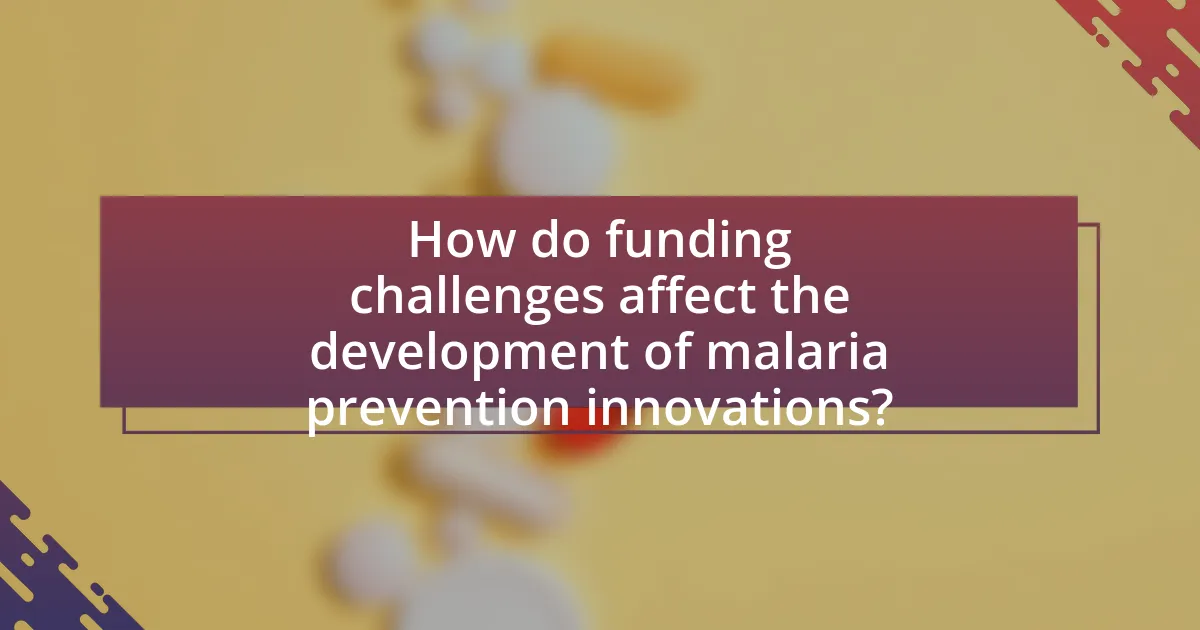
How do funding challenges affect the development of malaria prevention innovations?
Funding challenges significantly hinder the development of malaria prevention innovations by limiting financial resources necessary for research, development, and implementation. Insufficient funding restricts the ability of researchers and organizations to explore new technologies, conduct clinical trials, and scale effective interventions. For instance, the Global Fund reported that funding shortfalls have led to delays in the rollout of new malaria vaccines and treatments, which are crucial for combating the disease. Additionally, a study published in The Lancet highlighted that inadequate investment in malaria research results in fewer breakthroughs, ultimately prolonging the disease’s impact on affected populations.
What impact do funding shortages have on research and development?
Funding shortages significantly hinder research and development by limiting resources necessary for innovation and experimentation. When financial support is inadequate, research projects may face delays, reduced scope, or even cancellation, which directly impacts the advancement of new technologies and solutions. For instance, a study published in the journal “Nature” highlighted that insufficient funding for malaria research has led to slower progress in developing effective vaccines and treatments, ultimately affecting public health outcomes. Consequently, the lack of investment not only stifles scientific discovery but also prolongs the burden of diseases like malaria, which could be mitigated through timely research advancements.
How does limited funding slow down the innovation cycle in malaria prevention?
Limited funding significantly slows down the innovation cycle in malaria prevention by restricting research and development activities. When financial resources are scarce, organizations and researchers face challenges in conducting comprehensive studies, developing new technologies, and implementing effective interventions. For instance, a report by the Global Fund indicates that inadequate funding leads to delays in clinical trials and the deployment of new malaria vaccines, which can take years to develop and test. Consequently, the lack of investment hampers the ability to respond swiftly to emerging malaria strains and reduces the overall effectiveness of prevention strategies.
What are the consequences of funding gaps on clinical trials for new malaria interventions?
Funding gaps significantly delay the progress of clinical trials for new malaria interventions. These delays can result in prolonged timelines for bringing effective treatments and vaccines to market, ultimately hindering efforts to combat malaria, which affects millions globally. For instance, a study published in The Lancet Infectious Diseases highlighted that insufficient funding can lead to the cancellation of promising trials, as seen in the case of several vaccine candidates that failed to advance due to financial constraints. Additionally, funding shortages can limit the scope of research, reducing the diversity of interventions being tested and potentially overlooking innovative solutions. This creates a cycle where the lack of investment leads to fewer breakthroughs, perpetuating the malaria burden in affected regions.
How do funding challenges influence collaboration among stakeholders?
Funding challenges significantly hinder collaboration among stakeholders by limiting resources available for joint initiatives. When funding is scarce, stakeholders such as governments, NGOs, and private sector entities may prioritize their own projects over collaborative efforts, leading to fragmented approaches in malaria prevention. For instance, a study published in the Malaria Journal highlighted that inadequate funding often results in competition for limited resources, which can create barriers to effective partnerships and shared goals. This competition diminishes trust and reduces the willingness of stakeholders to engage in collaborative strategies, ultimately impacting the effectiveness of malaria prevention innovations.
What role does funding play in fostering partnerships between public and private sectors?
Funding serves as a critical enabler in fostering partnerships between public and private sectors by providing the necessary financial resources to support collaborative initiatives. These financial resources facilitate joint projects, research, and development efforts that address public health challenges, such as malaria prevention. For instance, the Global Fund to Fight AIDS, Tuberculosis and Malaria has invested over $4 billion in malaria programs, demonstrating how funding can catalyze cooperation between governments and private entities to implement effective interventions. This financial backing not only incentivizes private sector innovation but also aligns public health goals with market-driven solutions, ultimately enhancing the effectiveness of malaria prevention strategies.
How can funding challenges hinder international collaboration on malaria prevention?
Funding challenges can significantly hinder international collaboration on malaria prevention by limiting resources available for joint initiatives. When funding is scarce, countries may struggle to allocate sufficient financial support for collaborative research, shared technology, and coordinated public health campaigns. For instance, the Global Fund to Fight AIDS, Tuberculosis and Malaria reported that insufficient funding has led to a decline in malaria prevention efforts in various regions, demonstrating that financial constraints directly impact the effectiveness of international partnerships. Additionally, without adequate funding, countries may prioritize their own national health issues over collaborative efforts, further isolating initiatives and reducing the overall impact on malaria prevention globally.

What strategies can be employed to overcome funding challenges for malaria prevention innovations?
To overcome funding challenges for malaria prevention innovations, organizations can employ strategies such as diversifying funding sources, leveraging public-private partnerships, and utilizing innovative financing mechanisms. Diversifying funding sources allows organizations to reduce reliance on a single donor, thereby increasing financial stability; for example, the Global Fund has successfully mobilized resources from multiple governments and private entities to support malaria initiatives. Public-private partnerships can enhance resource mobilization and innovation, as seen in collaborations between pharmaceutical companies and non-profits that have led to the development of new malaria treatments. Additionally, innovative financing mechanisms, such as social impact bonds, can attract private investment by linking financial returns to measurable health outcomes, which has been demonstrated in various health sectors. These strategies collectively enhance the sustainability and scalability of malaria prevention efforts.
How can innovators attract more funding for malaria prevention projects?
Innovators can attract more funding for malaria prevention projects by demonstrating the potential impact and scalability of their solutions. Engaging with stakeholders, including governments, NGOs, and private investors, is crucial to showcase the effectiveness of their innovations through data-driven results. For instance, the World Health Organization reported that every dollar invested in malaria prevention yields a return of $36 in economic benefits, highlighting the financial viability of such projects. Additionally, forming partnerships with established organizations can enhance credibility and access to funding networks, as seen in successful collaborations like the Global Fund to Fight AIDS, Tuberculosis and Malaria, which has mobilized over $4 billion for malaria initiatives.
What best practices can be adopted to improve grant application success rates?
To improve grant application success rates, applicants should focus on tailoring their proposals to align closely with the funder’s priorities and guidelines. This involves thoroughly researching the funding organization to understand their mission, goals, and specific interests, which can significantly enhance the relevance of the application. Additionally, providing clear, measurable objectives and demonstrating the potential impact of the proposed project can strengthen the application. According to a study published in the Journal of Research Administration, proposals that included specific metrics for success were 30% more likely to receive funding. Furthermore, engaging stakeholders and incorporating their feedback can improve the proposal’s quality and relevance, leading to higher success rates.
How can leveraging public-private partnerships enhance funding opportunities?
Leveraging public-private partnerships can enhance funding opportunities by combining resources, expertise, and risk-sharing between the public sector and private entities. This collaboration allows for increased investment in malaria prevention innovations, as private companies can provide capital and technological advancements while public entities can offer regulatory support and access to broader networks. For instance, the Global Fund to Fight AIDS, Tuberculosis and Malaria has successfully utilized public-private partnerships to mobilize over $4 billion in funding, demonstrating the effectiveness of this approach in addressing health challenges.
What role does advocacy play in addressing funding challenges?
Advocacy plays a crucial role in addressing funding challenges by mobilizing support and resources for malaria prevention innovations. Through targeted campaigns, advocacy raises awareness among policymakers and stakeholders about the importance of funding for effective malaria interventions. For instance, organizations like the Global Fund have successfully advocated for increased financial commitments from governments and private sectors, resulting in billions of dollars allocated to combat malaria. This demonstrates that advocacy not only highlights the urgency of funding needs but also influences decision-makers to prioritize financial support for malaria prevention initiatives.
How can raising awareness about malaria prevention needs influence funding decisions?
Raising awareness about malaria prevention needs can significantly influence funding decisions by highlighting the urgency and importance of addressing the disease. Increased awareness can lead to greater public and private sector interest, prompting stakeholders to allocate resources towards effective prevention strategies. For instance, campaigns that educate communities about malaria’s impact can mobilize support from governments and NGOs, resulting in increased funding. According to the World Health Organization, targeted awareness initiatives have been shown to improve funding outcomes, as seen in the Global Fund’s efforts, which raised over $14 billion for malaria and other diseases in 2019, largely due to heightened awareness and advocacy.
What strategies can be used to engage policymakers in funding discussions?
To engage policymakers in funding discussions for malaria prevention innovations, stakeholders should utilize data-driven advocacy, build strategic partnerships, and communicate clear, actionable proposals. Data-driven advocacy involves presenting compelling evidence of the effectiveness and cost-efficiency of malaria prevention strategies, such as the 50% reduction in malaria cases achieved through the use of insecticide-treated nets, as reported by the World Health Organization. Building strategic partnerships with influential organizations and community leaders can amplify the message and create a united front, increasing the likelihood of policymakers prioritizing funding. Additionally, presenting clear, actionable proposals that outline specific funding needs and expected outcomes can facilitate informed decision-making among policymakers, ensuring that discussions are focused and productive.
What practical steps can be taken to ensure sustainable funding for malaria prevention innovations?
To ensure sustainable funding for malaria prevention innovations, stakeholders should establish public-private partnerships that leverage resources and expertise from both sectors. These partnerships can facilitate the pooling of financial resources, enabling more comprehensive funding strategies. For instance, the Global Fund to Fight AIDS, Tuberculosis and Malaria has successfully mobilized billions through such collaborations, demonstrating the effectiveness of combining governmental, philanthropic, and corporate funding sources. Additionally, implementing innovative financing mechanisms, such as social impact bonds, can attract private investment by linking returns to measurable health outcomes, thereby ensuring ongoing financial support for malaria prevention initiatives.

